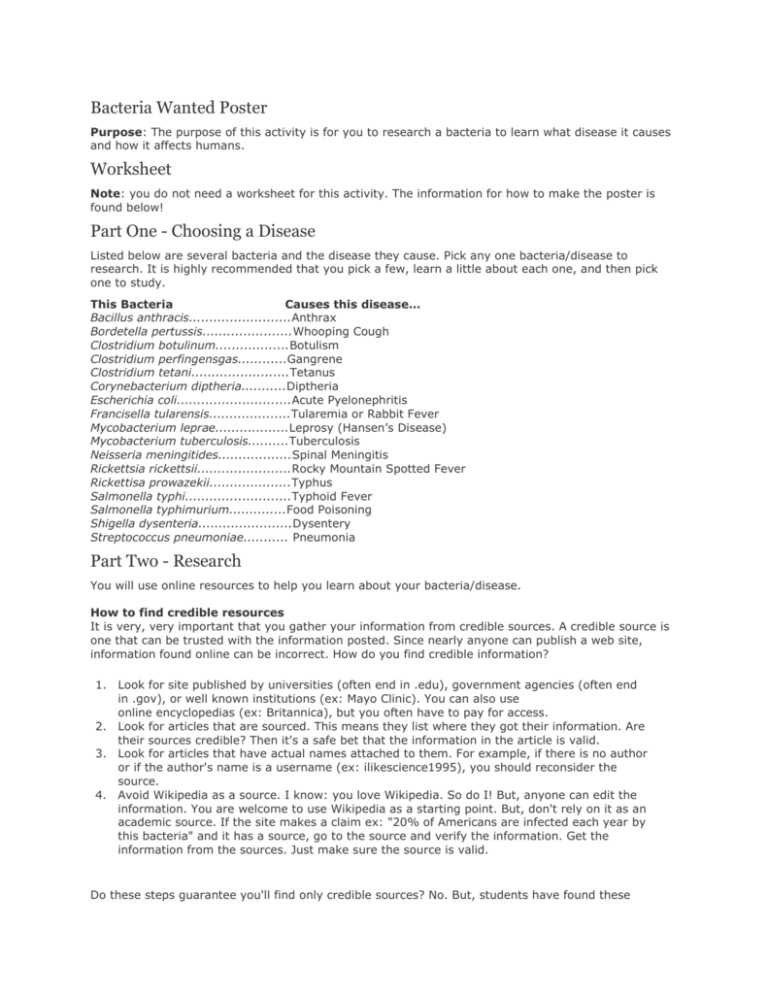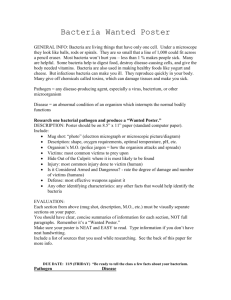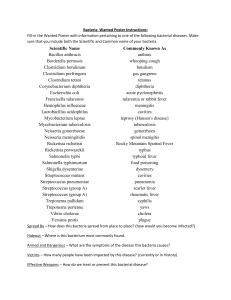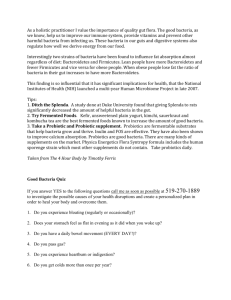Bacteria Wanted Poster Purpose: The purpose of this activity is for
advertisement

Bacteria Wanted Poster Purpose: The purpose of this activity is for you to research a bacteria to learn what disease it causes and how it affects humans. Worksheet Note: you do not need a worksheet for this activity. The information for how to make the poster is found below! Part One - Choosing a Disease Listed below are several bacteria and the disease they cause. Pick any one bacteria/disease to research. It is highly recommended that you pick a few, learn a little about each one, and then pick one to study. This Bacteria Causes this disease… Bacillus anthracis.........................Anthrax Bordetella pertussis......................Whooping Cough Clostridium botulinum..................Botulism Clostridium perfingensgas............Gangrene Clostridium tetani........................Tetanus Corynebacterium diptheria...........Diptheria Escherichia coli............................Acute Pyelonephritis Francisella tularensis....................Tularemia or Rabbit Fever Mycobacterium leprae..................Leprosy (Hansen’s Disease) Mycobacterium tuberculosis..........Tuberculosis Neisseria meningitides..................Spinal Meningitis Rickettsia rickettsii.......................Rocky Mountain Spotted Fever Rickettisa prowazekii....................Typhus Salmonella typhi..........................Typhoid Fever Salmonella typhimurium..............Food Poisoning Shigella dysenteria.......................Dysentery Streptococcus pneumoniae........... Pneumonia Part Two - Research You will use online resources to help you learn about your bacteria/disease. How to find credible resources It is very, very important that you gather your information from credible sources. A credible source is one that can be trusted with the information posted. Since nearly anyone can publish a web site, information found online can be incorrect. How do you find credible information? 1. Look for site published by universities (often end in .edu), government agencies (often end in .gov), or well known institutions (ex: Mayo Clinic). You can also use online encyclopedias (ex: Britannica), but you often have to pay for access. 2. Look for articles that are sourced. This means they list where they got their information. Are their sources credible? Then it's a safe bet that the information in the article is valid. 3. Look for articles that have actual names attached to them. For example, if there is no author or if the author's name is a username (ex: ilikescience1995), you should reconsider the source. 4. Avoid Wikipedia as a source. I know: you love Wikipedia. So do I! But, anyone can edit the information. You are welcome to use Wikipedia as a starting point. But, don't rely on it as an academic source. If the site makes a claim ex: "20% of Americans are infected each year by this bacteria" and it has a source, go to the source and verify the information. Get the information from the sources. Just make sure the source is valid. Do these steps guarantee you'll find only credible sources? No. But, students have found these guidelines helpful in identifying sites with valid information. If you're unsure, ask your teacher and they'll be able to help you. Keep track of your sources! You can use Easy Bib or Citation Machine. The Links are located on the NHS Resource page. Write down your sources. You must include: 1. 2. 3. 4. Author Name of site or page Web address (URL) of page Date the page was published or reviewed (if you can't find a publish date, write down the date you accessed it) How to find an image of your bacteria While you read sites about your bacteria, you're likely to find a picture of your bacteria. If you don't, cautiously use Google Images. Not all the image results will be of your bacteria. Also, search for the bacteria, not the disease. If you search for the disease, you'll most likely get pictures of what the disease does to humans, not how the bacteria looks. What you must research: 1. 2. 3. 4. 5. 6. 7. A picture of the bacteria Description of bacteria (shape, characteristics, etc.) How the bacteria/disease spreads Where the bacteria is often found (ex: body fluids, spoiled foods, etc.) What symptoms an infected person has The best cure to the infection Who the bacteria targets or who is most likely to be infected (kids, adults, elderly, those who eat raw food, etc.) Part Three - Making the Poster Sample poster created by Mr. Ower. Once you finished your research you can make you poster. It's up to you to design the layout outside the requirements below. You can see an example above. Requirements: 1. 2. 3. 4. Large "WANTED" text at the top Below the WANTED text write the name of the bacteria and the disease it causes. Below that include the picture along with the description of the bacteria. Areas of the poster that list: a. "Culprit's MO" (How the bacteria/disease spreads) b. "Victims" (Who the bacteria targets...) c. "You're in Danger If..." (Symptoms) d. "How to get Help" (Best cure) e. "Hide Outs" (Where the bacteria is often found) 5. On the back of the poster list your sources in this format: - Title of Page, URL, Date Publish/Reviewed/Accessed Complete this on a standard sheet of printer paper (8.5 x 11 inches). You may complete it on a larger sheet of paper. You are welcome to make the paper look more western by dying it a shade of tan, crumpling it, adding small burn marks, etc. Be creative! When you finish your poster, turn it in to your teacher. Copyright 2010-2011 Pete Ower. Some images and content provided by other authors and is cited as such. Wilmette Links: Team 7B Home Page | District 39 Home Page | WJHS Home Page









